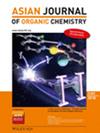微晶纤维素和纳米纤维素:绿色有机转化的非均相纳米催化中的生态友好和可持续支持材料
IF 2.8
4区 化学
Q1 CHEMISTRY, ORGANIC
引用次数: 0
摘要
利用微晶纤维素(MCC)和纤维素纳米晶体(CNC)作为纳米催化剂的载体,由于其独特的性能和若干优点,近年来引起了人们极大的兴趣。在这方面,我们介绍了MCC或cnc基纳米催化剂的使用及其在温和和可持续的反应条件下在有机反应中的催化性能。MCC的丰度、生物相容性和多用途表面等固有优势使其成为纳米催化剂更有吸引力的支撑材料。同样,cnc具有高表面积、可调表面化学性质和可持续性,为增强催化过程提供了广阔的前景。纤维素基材料和纳米颗粒之间的协同作用表现出几种新的特性。本文综述了MCC和cnc支持的纳米催化剂的主要特点、优势及其催化应用,强调了它们在促进更可持续和高效的有机转化方面的作用。本文章由计算机程序翻译,如有差异,请以英文原文为准。

Microcrystalline Cellulose and Cellulose Nanocrystals: Ecofriendly and Sustainable Support Materials in Heterogeneous Nanocatalysis for Green Organic Transformations
The utilization of microcrystalline cellulose (MCC) and cellulose nanocrystals (CNC) as supports for nanocatalysts has garnered considerable interest in recent research due to their unique properties and several advantages. In this regard, we present a review of the use of MCC or CNC‐based nanocatalysts and their catalytic performance in organic reactions under milder and sustainable reaction conditions. The inherent advantages of MCC, such as its abundance, biocompatibility, and versatile surface, make it more attractive support material for nanocatalysts. Similarly, CNCs, with their high surface area, tunable surface chemistry, and sustainable nature, offer promising prospects for enhancing catalytic processes. The synergy between the cellulose‐based material and nanoparticles exhibits several novel properties. This review highlights the key features, advantages, and catalytic applications of MCC as well as CNC‐supported nanocatalysts, emphasizing their role in promoting more sustainable and efficient organic transformations.
求助全文
通过发布文献求助,成功后即可免费获取论文全文。
去求助
来源期刊

Asian Journal of Organic Chemistry
CHEMISTRY, ORGANIC-
CiteScore
4.70
自引率
3.70%
发文量
372
期刊介绍:
Organic chemistry is the fundamental science that stands at the heart of chemistry, biology, and materials science. Research in these areas is vigorous and truly international, with three major regions making almost equal contributions: America, Europe and Asia. Asia now has its own top international organic chemistry journal—the Asian Journal of Organic Chemistry (AsianJOC)
The AsianJOC is designed to be a top-ranked international research journal and publishes primary research as well as critical secondary information from authors across the world. The journal covers organic chemistry in its entirety. Authors and readers come from academia, the chemical industry, and government laboratories.
 求助内容:
求助内容: 应助结果提醒方式:
应助结果提醒方式:


